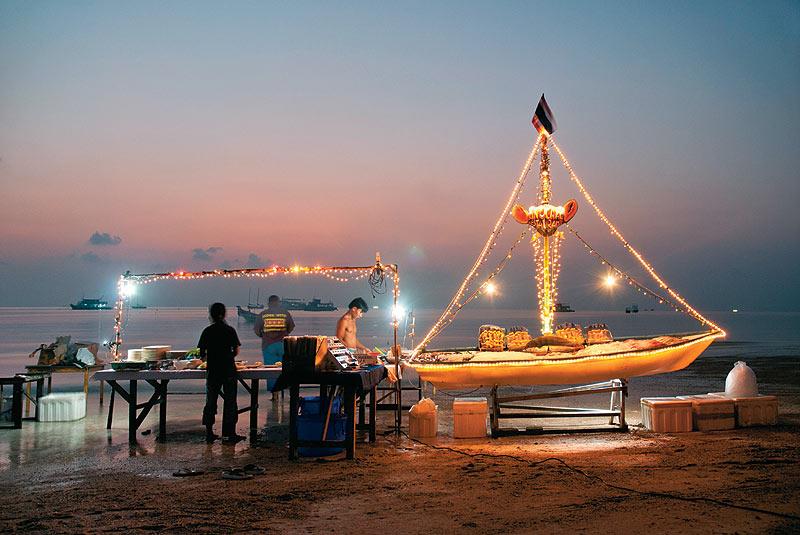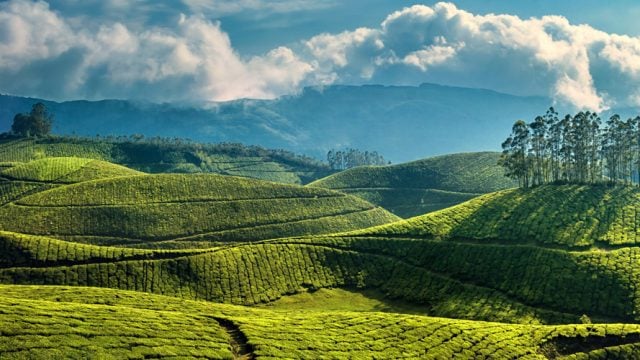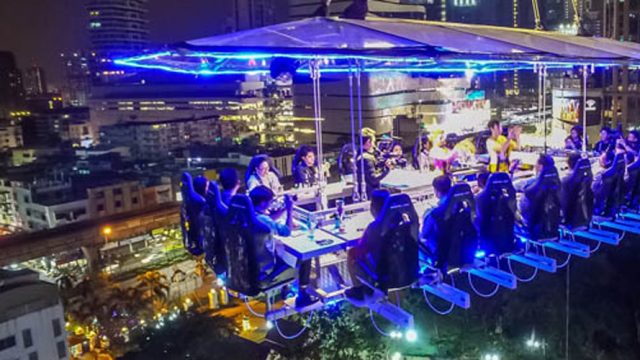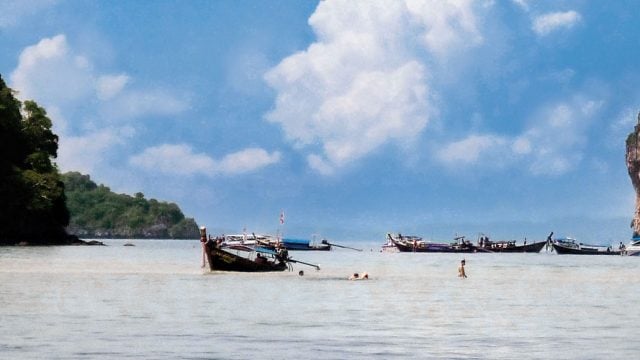The plan: a couple of days in Bangkok, four days on the island paradise of Koh Tao
After a couple of hours in the visa queue and another hour in the metro, I finally reach the Phranakorn Nornlen, a quirky boutique hotel in a quiet corner of Old Bangkok. The Nornlen’s theme is slow, simple living, and the place is a welcome refuge from the bustle of Bangkok. At the entrance is a garden; immediately within is a café with displays of old televisions and sewing machines. I’m shown up to my room, and it has an antique wooden TV as a bedside table. Painted on one wall is a hen that transforms into a paper plane before shattering the wall. Above my bed, a cluster of bright blue fish jumps out of the wall. The bathroom is a refinery of curvy brass tubing against a faux run-down brick structure. Everything in the Nornlen is a little beautiful and a little strange and, put together, it somehow feels perfect. I plan my day with help from the ever-obliging staff and the hand-painted map behind the reception desk.
Tuk-tuks and taxis are an option but, if you’re on a budget, the best way to get around Old Bangkok is the Chao Phraya river. Most places in the old city are easily walkable from one pier or the other after a brief and inexpensive ferry ride. From the Nornlen I have to walk down to the Thewet pier, where people, to square their karma, throw down heels of bread to a roiling mass of obviously overfed fish. This, I realise, is the scene painted above my bed in the Nornlen.
I sail under the cabled scalene of the Rama VIII bridge and walk to the complex of the Grand Palace and the Temple of the Emerald Buddha. This is the main tourist attraction in the area, and for good reason, I discover. But first, I face a fiscal crisis. In India I am used to shelling out ten rupees and sauntering into monuments past foreigners who are grimly counting out their hundreds. Here the tables are turned: Thais get in for free while foreigners pay four hundred baht. I realise I’ve completely forgotten about entrance tickets in my budget calculations. I stand there for a while, indignant, and consider turning back. But that, I tell myself, is throwing the baby out with the bahtwater, so I grudgingly count out the hundreds.
The complex is a dizzyingly spectacular place: a cluster of spires, colourful sloping roofs and polished mosaic surfaces; statues and figurines ranging from the giant yakshis at the entrance to the Garudas that hold up the structures to the intricate Emerald Buddha (carved actually in jade); dense frescoes of the Ramakien and the Buddha’s life; and all this set amidst what has to be the most massive gilt-trip on earth.
The Ramakien is a version of the Ramayana that serves as the Thai national epic. Every king of Thailand is apparently named King Rama (we’re on Rama IX at the moment, whose photographs are everywhere) and the old capital of Thailand was called—what else—Ayutthaya.
But in terms of religion, it’s the Buddha who’s big in Thailand. Literally so in the Wat Pho, an enormous temple complex with a 43-metre-long statue of the reclining Buddha as its centrepiece. There’s also a Thai massage school here which is generally thought of as being the real deal. Across the river is the Wat Arun, a monastery and temple with porcelain encrusted towers. (If Chandigarh’s Rock Garden took itself very seriously and gathered itself to its full height, this is what it might become.)
Most backpackers in Bangkok head straight for Khao San Road, a densely packed buffet of everything a foreign tourist might need: currency exchange, McDonald’s, KFC, cheap clothes, supermarkets, travel agents, guesthouses that cost next to nothing, other tourists to party with. The place is worth visiting just to witness the cauldron of liveliness it turns into as the night advances.
Everything said in Thai sounds imploring, and this seems to rub off on the cadences of their English. Even the persistent and astonishingly versatile Khao San Road agent with everything on offer from tuk-tuks to air-tickets to women comes across as downright solicitous. And there seems to be a general preference for the cute: soft toys and cartoon characters everywhere; even in the Ramakien, Hanuman’s antics occupy centre-stage and Rama and Sita get a happily-ever-after ending. This, I think to myself at the end of my first day in Bangkok, is a culture that emphasises the pleasant and polite, the gentle and reticent.
I’m not so sure the next morning after being at the receiving end of a Thai massage. The deceptively diminutive P’Pen starts gently enough with my feet, but by the time she has clambered upon me to bear down with her knees and elbows, I’ve realised that the word ‘massage’ is being interpreted somewhat loosely. P’Pen admits as much. She is holding up one of my legs and pounding its hamstring with her fist when she notices my goggle-eyed imitation of one of the Wat yakshis, laughs, and says, “Thai boxing!” Then there’s the shoulder clench she executes that leaves my eyes watering. But really, I feel pretty good at the end of it all. P’Pen has even uncricked a crick in my neck acquired on the flight in. I’ll happily recommend a Thai massage to just about anyone, but be aware that it’s one of those no-pain-no-gain deals that life seems to be so full of.
English works to an extent in the tourist areas, but communication can be a problem in other places. This sometimes has consequences. I take a bus from the old city to the railway station with the understanding that the station is the last stop. As my train’s departure time approaches I grow nervous and finally ask my neighbour on the bus. (All I can say is the name of the railway station: Hua Lamphong.) After some frantic back-and-forth signing I realise we’ve left the station far behind. My neighbour touchingly pulls out his GPS smartphone and shows me where we are, and where I have to be. In the meanwhile, it has started to rain and traffic slows to a crawl. I get off the bus and manage to find a motorcycle taxi, the only way to cut through a Bangkok traffic jam. I make it to the station just in time after a hair-raising ride.
Mine is an overnight train to Chumphon in southern Thailand. The two overnight train journeys in my itinerary are a way of saving time as well as money on room tariff. But this works well only if the trains are comfortable enough to leave one a functioning human being the next morning. I find that in this department, it is hard to find fault with the State Railway of Thailand. My second-class AC ticket costs about the same as a similar journey on the Indian Railways, but the ride is far more comfortable. There’s a nice restaurant car, and they will ply you with food and drink at your seat. But the real star is the bed. A smartly uniformed attendant (with military-style decorations on his chest, presumably for bed-making) by some intricate means converts the ample seats into a clean, cosy, spacious bed. I don’t think I have ever slept so well on a train.
Koh Tao—Turtle Island—is 74km from Chumphon in the Gulf of Thailand. The island was uninhabited until the early decades of the twentieth century, when it was used as a political prison for a while—a sort of Thai kalapaani, except for the waters being balmy and gloriously clear. (Since there are no confining structures visible on the island, one assumes the prisoners spent their time lazing about the beaches ruing whatever machinations brought them there, and thinking that, you know, things might have been worse.) In the last couple of decades, Koh Tao has emerged as a prime destination for diving and other watery pursuits.
The 21 sq km island is populated in small pockets. Mae Haad village on the western side is the nerve-centre of the island—this is where the piers are, along with the best restaurants and cafés, shops, and a variety of lodgings. I’m staying in a ‘garden-view bungalow’ at the Ananda Villa, a couple of minutes away from the piers. A ten-minute walk to the north is Sairee—the longest and most developed beach of Koh Tao, with a concentration of clubs, bars, restaurants and guesthouses. Sairee is comparatively the more boisterous area: places stay open late; there are after-full-moon parties; a sign reads, ‘Laughing gas available here’. Mae Haad is somewhat sedate and in bed by eleven or so. The rest of the island is mostly jungle and steep paths with scattered resorts and guesthouses overlooking bays. There’s something in Koh Tao for everyone from the party animal to the hermit.
But all that is incidental. What matters is that Koh Tao is rimmed by unspoilt beaches and calm, pristine waters with a stunningly rich marine life. The coral reefs are so intricate, dense and dazzling in their colour and variety that the Temple of the Emerald Buddha feels like a poor terrestrial imitation. Days here are most properly spent in the water with a snorkelling or diving mask on, among fish (and the occasional harmless shark) between whom all sorts of incomprehensible stories are being played out. Sadly, this world may be on its way out—coral reefs across the world are dying, and some marine ecologists doubt there’ll be any left in a few decades. So, if you’ve been putting off that seaside vacation…
I go on a day-long snorkelling trip in which a boat takes a group around the island to different bays and the protected island of Koh Nangyuan. On the other days I walk through the hills to explore nearby beaches. Mornings and nights are for sampling cafés and restaurants. I’ve only worked through the ones in Mae Haad when it’s time to leave.
Back to Bangkok, where I put to good use the shower and cloakroom facilities at the Hua Lamphong station. (There’s an ultra-low-budget tour of Thailand waiting to be done entirely through the railway system.) I take a train to nearby Ayutthaya, once the capital of the Siamese kingdom, and the world’s most populous city at the turn of the eighteenth century. The Burmese army then ran it over, and all that’s left now are temple towers and expanses of bare brick. I hire a bicycle to ride through the ruins and take a train back to the present capital for my flight back.
What of the budget? Twenty thousand rupees proved more than enough for six nights and seven days. It looks like I’ll soon have to make out a small cheque to the magazine. But there are other things that will stay with me: the story of the Burmese immigrant who speaks to me in Hindi about the persecution of Muslims there; watching the Wimbledon men’s final in a Koh Tao bar packed with Brits with a lone woman cheering for Federer; hanging on behind a motorcycle in the rain as the driver darts and swerves through traffic so I can make my train.
The information
Visas
A 15-day tourist visa is issued on arrival if you can show a return ticket (THB 1,000). Keep a photograph handy. The queue moves slowly, so it helps to get in line early.
Currency
There are exchange counters at the airport before the visa counters. These don’t list the Indian rupee on their rate chart, so be armed with dollars or euros.
Tip
Most ATMs in Thailand charge THB 150 per withdrawal for foreign cards, but AEON, Citibank and HSBC machines don’t. You can also get cash against your Visa cards at exchange booths—there’s one on Khaosan Road, Bangkok and another in Mae Haad, Koh Tao.
When to go
A good period to visit Koh Tao is from July to September, or December to March. It can be too hot or too wet at other times.
Bangkok
Getting there
Depending on which city you’re flying out from, how far in advance you book and what time of year you plan to travel, return economy class tickets to Bangkok cost anything between Rs 15,000 and Rs 25,000. A variety of airlines fly to Bangkok, including Thai, IndiGo, Jet and Air India.
Getting around
There are as many ways to get around Bangkok as the city is large and unwieldy. Buses, tuk-tuks and taxis are all vulnerable to traffic jams that can form at any time. The Chao Phraya river taxi and express boats are particularly convenient for moving around Old Bangkok, where many of the tourist sights are. The Skytrain (BTS) and the underground rail system (MRT) together cover large parts of the city. (A route planner, maps and time-tables for all forms of public transport can be found at transitbangkok.com).
Where to stay
I stayed at the charming and very slightly out of the way Phranakorn Nornlen. My single room cost THB 1,800, and came with breakfast, a meal and a discounted Thai massage. A double room is THB 2,200 and the family room for four is THB 3,600 (phranakornnornlen.com). An interesting place to stay could be the self-evidently named Shanghai Mansion in Chinatown (THB 2,500–3,100; shanghaimansion.com). The Rikka Inn is a comfortable oasis on Khaosan Road (THB 750–1,850; rikkainn.com). Bangkok is famed for its cheap hotel rooms and there are always great deals going. Check online at bangkok.com.
What to see & do
Bangkok is endless in its possibilities and everyone will want to do something different. If I had more time I might have tried the canal tour of Thonburi, the site where Bangkok was founded (around THB 2,000). Or a Thai boxing match for the sheer intensity of local colour (midrange tickets are around THB 1,000). The Siam Niramit show is supposed to be a spectacular introduction to the history and culture of Thailand (THB 1,300). Or I’d have gone to see the Calypso Ladyboy Cabaret’s much-acclaimed musical production (THB 900).
Tip The Absolute Explorer cycling tours go to Bangkok’s outskirts for a fresh look away from the tourist scene (THB 1,300–1,500; absoluteexplorer.com).
Where to eat
There is an immense variety of good, cheap street food ranging from fresh fruit to barbecued meats. Small, local restaurants can be very good, and it shouldn’t be hard to get a satisfying plate of Pad Thai for around THB 50. Vegetarians should have no trouble since many Thai dishes are easily prepared without meat. At Bangkok I ate mostly off the street or from the kitchen of the Phranakorn Nornlen (around THB 120 per dish). Singha and Chang beers are ubiquitous and will even be pressed upon you in trains. The latter is strong and tourists clutching their heads will often mutter in explanation, “Changover.”
Koh Tao
Getting there
I took the overnight train No. 85 from Bangkok, which leaves enough time to get to the pier in Chumphon for the morning ferry to Koh Tao. A second class AC lower berth ticket costs THB 690 baht one way. Tickets can be booked online (thairailticket.com).
Tip
Lower berths are marginally more expensive but much more comfortable. You could save around THB 200 by booking second class without AC. Given the arctic AC levels, this may even be more comfortable.
The most reliable ferry service to Koh Tao is run by Lomprayah, who offer free transfer from the train station to their pier. The ticket costs THB 600 baht one way. Book at lomprayah.com.
Getting around
Boat taxis will take you from one part of the island to another for a couple of hundred baht, as will jeeps. You can hire a motorcycle for around THB 200 a day, but given the gradients and the quality of roads, your exploration is likely to be limited. Beware of scamsters who rent out motorcycles and make you pay for pre-existing scratches and dents.
Where to stay
In Koh Tao I stayed at Ananda Villa at Mae Haad, just a couple of minutes from the pier (anandavilla.com). My garden bungalow without AC cost THB 500 per night. They have a range of bungalows and rooms from THB 500 to THB 1,800, all excellent value for money. A highly recommended budget place in Mae Haad is the Captain Nemo guesthouse (THB 650–1,650; captainnemo-kohtao.com). On the road leading from Mae Haad to Sairee is Mr J Bungalow, whose attached shop should be a tourist destination for its extreme and arbitrary variety and for the presence of the singularly idiosyncratic Mr J (THB 600–1,500; mrjbungalow.resort.kohtaoisland.net).
Where to eat
Some of Koh Tao’s best restaurants and cafés are in Mae Haad. The Cappuccino Bistro and Café del Sol are both fine bakeries and coffee shops that serve set breakfasts and more. (My breakfasts there cost THB 100 and 140, respectively.) Pranee’s Kitchen, right next to Ananda Villa, is great value for money (THB 80–120 per dish). The place to go for special occasions is the austerely decorated Whitening, thought of by many as the best restaurant in Koh Tao, but quite reasonably priced. (I paid THB 360 for a drink, starter and main course.) The place to go for Italian food is Dolce Vita, run by an Italian who believes in making everything from scratch. (A full dinner here cost me THB 480.)
What to see & do
Koh Tao is a hub for divers and quite a few people come here to earn diving certificates. Master Divers (master-divers.com) and Crystal Dive (crystaldive.com) are two well regarded places. Almost every other shop here offers a standardised snorkelling package for 850 baht (cheaper if booked through your hotel). These also take people fishing with ‘catch guaranteed’. Koh Tao has a number of viewing points that make for good hikes. Goodtime Adventures (gtadventures.com) organises rock climbing, bouldering, skin diving, cliff jumping and other dangerous sounding activities.
Koh Tao
Old Bangkok
Thailand on a budget
Leave a Reply
You must be logged in to post a comment.





